Coordinate Geometry Exercise 14.1 (Part-3) | Extra Documents, Videos & Tests for Class 10 PDF Download
Question 37: If the point A(0, 2) is equidistant from the points B(3, p) and C(p, 5), find p. Also, find the length of AB. [CBSE 2014]
Answer :
It is given that A(0, 2) is equidistant from the points B(3, p) and C(p, 5).
∴ AB = AC

 (Distance formula)
(Distance formula)
Squaring on both sides, we get
9+p2−4p+4=p2+9⇒−4p+4=0⇒p=1
Thus, the value of p is 1.


Question 38: Name the quadrilateral formed, if any, by the following points, and given reasons for your answers:
(i) A(−1,−2) B(1, 0), C (−1, 2), D(−3, 0)
(ii) A(−3, 5) B(3, 1), C (0, 3), D(−1, −4)
(iii) A(4, 5) B(7, 6), C (4, 3), D(1, 2)
Answer(i) A (−1,−2) , B(1,0), C(−1,2), D(−3,0)
Let A, B, C and D be the four vertices of the quadrilateral ABCD.
We know the distance between two points P and Q
and Q is given by distance formula:
is given by distance formula:

Hence
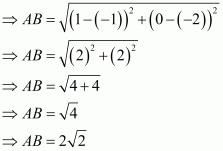
Similarly,
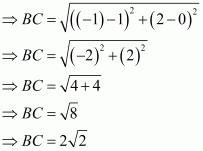
Similarly,
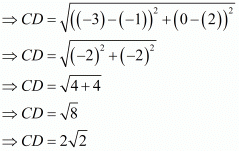
Also,
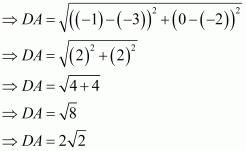
Hence from above we see that all the sides of the quadrilateral are equal. Hence it is a square.
(ii) A (−3,5) , B(3,1), C(0,3), D(−1,−4)
Let A, B, C and D be the four vertices of the quadrilateral ABCD.
We know the distance between two points P and Q
and Q is given by distance formula:
is given by distance formula:

Hence
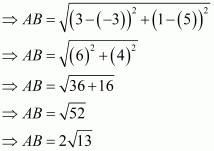
Similarly,
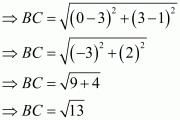
Similarly,

Also,
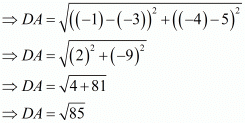
Hence from the above we see that it is not a quadrilateral
(iii) A (4, 5), B (7,6), C(4,3), D(1,2)
Let A, B, C and D be the four vertices of the quadrilateral ABCD.
We know the distance between two points P and Q
and Q is given by distance formula:
is given by distance formula:

Hence
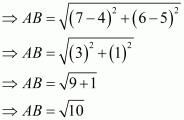
Similarly,
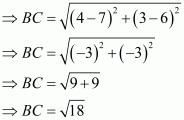
Similarly,
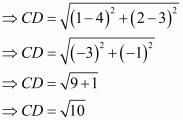
Also,
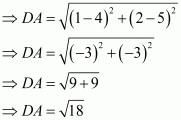
Hence from above we see that
AB = CD and BC = DA
Here opposite sides of the quadrilateral is equal. Hence it is a parallelogram.
Question 39: Find the equation of the perpendicular bisector of the line segment joining points (7, 1) and (3,5).
Answer :
TO FIND: The equation of perpendicular bisector of line segment joining points (7, 1) and (3, 5)
Let P(x, y) be any point on the perpendicular bisector of AB. Then,
PA=PB
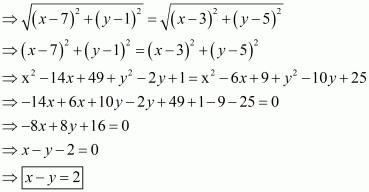
Hence the equation of perpendicular bisector of line segment joining points (7, 1) and (3, 5) is
Question 40: Prove that the points (3, 0), (4, 5), (−1, 4) and (−2 −1), taken in order, form a rhombus. Also, find its area.
Answer :
The distance d between two points  and
and  is given by the formula
is given by the formula

In a rhombus all the sides are equal in length. And the area ‘A’ of a rhombus is given as

Here the four points are A(3,0), B(4,5), C(−1,4) and D(−2,−1).
First let us check if all the four sides are equal.
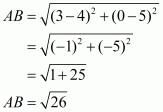
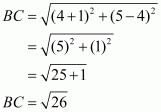
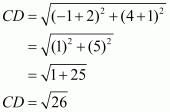
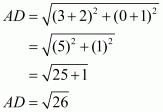
Here, we see that all the sides are equal, so it has to be a rhombus.
Hence we have proved that the quadrilateral formed by the given four vertices is a .
.
Now let us find out the lengths of the diagonals of the rhombus.
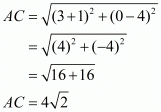

Now using these values in the formula for the area of a rhombus we have,
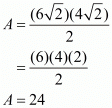
Thus the area of the given rhombus is .
.
Question 41: In the seating arrangement of desks in a classroom three students Rohini, Sandhya and Bina are seated at A(3, 1), B(6, 4), and C(8, 6). Do you think they are seated in a line?
Answer :
The distance d between two points  and
and  is given by the formula
is given by the formula

For three points to be collinear the sum of distances between any two pairs of points should be equal to the third pair of points.
The given points are A(3,1), B(6,4) and C(8,6).
Let us find the distances between the possible pairs of points.
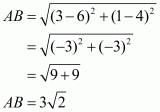
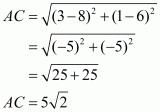
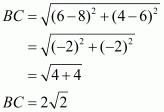
We see that .
.
Since sum of distances between two pairs of points equals the distance between the third pair of points the three points must be collinear.
Hence, the three given points are .
.
Question 42: Find a point on y-axis which is equidistant form the points (5, −2) and (−3, 2).
Answer :
The distance d between two points  and
and  is given by the formula
is given by the formula

Here we are to find out a point on the y−axis which is equidistant from both the points A(5,−2) and B(−3,2).
Let this point be denoted as C(x, y).
Since the point lies on the y-axis the value of its ordinate will be 0. Or in other words we have .
.
Now let us find out the distances from ‘A’ and ‘B’ to ‘C’


We know that both these distances are the same. So equating both these we get,

Squaring on both sides we have,

Hence the point on the y-axis which lies at equal distances from the mentioned points is .
.
Question 43: Find a relation between x and y such that the point (x, y) is equidistant from the points (3, 6) and (−3, 4).
Answer :
The distance d between two points  and
and  is given by the formula
is given by the formula

Let the three given points be P(x, y), A(3,6) and B(−3,4).
Now let us find the distance between ‘P’ and ‘A’.

Now, let us find the distance between ‘P’ and ‘B’.

It is given that both these distances are equal. So, let us equate both the above equations,

Squaring on both sides of the equation we get,

Hence the relationship between ‘x’ and ‘y’ based on the given condition is .
.
Question 44: If a point A(0, 2) is equidistant from the points B(3, p) and C(p, 5), then find the value of p. [CBSE 2012, 2013]
Answer : It is given that A(0, 2) is equidistant from the points B(3, p) and C(p, 5).
∴ AB = AC
⇒ (Distance formula)
(Distance formula)
Squaring on both sides, we get
9+p2−4p+4=p2+9⇒−4p+4=0⇒p=1
Thus, the value of p is 1.
Question 45: Prove that the points (7, 10), (−2, 5) and (3, −4) are the vertices of an isosceles right triangle. [CBSE 2013]
Answer
Let the given points be A(7, 10), B(−2, 5) and C(3, −4).
Using distance formula, we have


 units
units
BC=

 units
units
CA=

 units
units
Thus, AB = BC =  units
units
∴ ∆ABC is an isosceles triangle.
Also,
AB2 + BC2 = 106 + 106 = 212
and CA2 = 212
∴ AB2 + BC2 = CA2
So, ∆ABC is right angled at B. (Converse of Pythagoras theorem)
Hence, the given points are the vertices of an isosceles right triangle.
|
5 videos|292 docs|59 tests
|
|
5 videos|292 docs|59 tests
|

|
Explore Courses for Class 10 exam
|

|



























